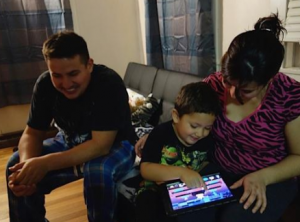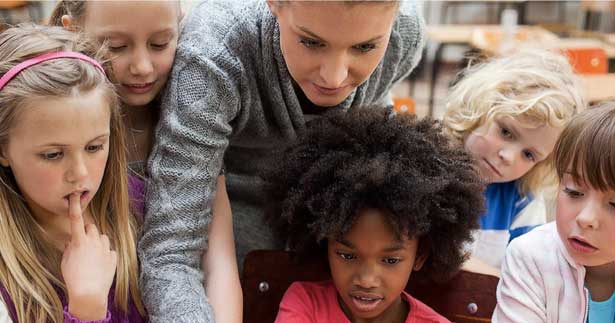Sitting at the table in his sunlit kitchen, Jayden was excited to show me a new video on his iPad. More proficient with the technology at age 5 than some adults, he pulled up a video on the screen and said, “Let’s start the magic trick!”

As we watch together, Jayden and his dad appear on the screen in the middle of their living room, accompanied by a large cardboard box. As the video plays, Jayden crawled into the box and his dad closed the lid… shouting the magic words, Abra Cadabra, his dad opened the box. Jayden had disappeared.
“It’s not a box… it’s magic!” he shouted, looking up from the screen at me and smiling.
Jayden and his parents made the video together after they read the children’s book, Not a Box. Throughout the book, an ordinary box is—with a little imagination—transformed into a rocket ship, a racecar, and many other fantastic items. The book captured Jayden’s imagination: his box wasn’t just a magic trick; in another video, he and his dad pretended the boxes were pirate ships, using their imaginary oars to row along.
Even more intriguing: This wasn’t a scene from a middle-class, Caucasian household: Jayden’s father is a migrant farmworker. He and his son were presenting their magic show in Spanish.
In the rural town of Milbridge, Maine, visiting with several families whose primary home language was Spanish, I saw example after example of creative, intentional use of new technologies for language learning. Not only were the children excited and engaged in learning, but their parents were confident in guiding them to these learning opportunities using new technologies.
In a country struggling to provide equitable early learning opportunities after the great recession, confronting an enormous word gap between low-income children and their more affluent peers, and often confounded by the additional challenge of educating dual-language learners, what is different about Milbridge, Maine? And, equally important, are there lessons there that resonate for the rest of the country?
Around fifteen years ago, Milbridge experienced an influx of migrant farmworkers. Then—as today—migrant families often pieced together year-round work through a combination of blueberry harvesting, wreathe-making, and other seasonal labor. While Milbridge’s residents are primarily white and English-speaking, the migrant families moving to the area were primarily Hispanic and Spanish-speaking.
Working to build a more inclusive community, the Milbridge Public Library, Town Office, and schools strove to improve and expand their programs and resources to serve both their English- and Spanish-speaking residents. In 2005, Mano en Mano (Hand in Hand)—a new, local non-profit—officially was formed to coordinate the provision of basic resources, education programs, and other services for migrant families new to the area.
Like many rural communities, Milbridge has just one small public school for children from kindergarten through eighth grade. There’s no local Head Start center, preschool program, or other early childhood education opportunities to speak of.
That began to change in the summer of 2012, when Mano en Mano started a new, and somewhat unusual, early childhood education program supported by federal funding for migrant education: Comienza en Casa, or “It Starts at Home.”
The Comienza en Casa program was designed to work closely with parents, through home visiting and monthly group meetings, providing them with the information and materials they need to promote their young children’s school readiness at home. The curriculum intentionally integrates new technologies—specifically iPads—in order to organize materials for parents, balancing screen time with activities to develop skills offline.
Jayden’s was one of four families approached that summer to join the program’s pilot. At the time, Juana Rodriguez Vazques, Jayden’s mother, told me that she was unsure what she could do to help her son learn in preparation for school. They did not have a tablet or broadband connection at home, and working with this technology was also an entirely new experience. The Comienza en Casa program set out to change both.

At the beginning of the program, they and the other families were given an iPad to use throughout each of the month-long units—the materials for each unit were pre-loaded on the devices. Ana Blagojevic, the program’s coordinator and home visitor, brought the iPads to each family’s home a few days before all the families first met as a group, giving each time to explore the materials independently. When they met, parents were able to learn from one another’s questions about the materials and the technology.
After that first meeting, Blagojevic visited each family to help parents one-on-one. Working with parents in both English and Spanish, she has been able to further explain the units and resources, as well as field further questions and help troubleshoot with the technology.
Bonnie Blagojevic, an education consultant who has worked with children for over twenty years, came to the program through her daughter’s involvement. She has become an expert in sifting through the vast assortment of digital literacy materials available. Culling through thousands of e-books, apps, and games, she and Ana have built each unit—organized around math, pre-literacy, and science concepts—through curating the best materials in English and Spanish.
Families in the community do not have consistent home access to broadband, so materials are limited in some respects. For example, before bringing the iPads to the families’ homes, Ana Blagojevic had to download videos so that they resided on the devices; there was not enough bandwidth at their homes for live-streaming.
Even so, from what I witnessed in my visit to Maine, parents quickly realized the devices were more than just screens—these iPads provided much-needed and language-accessible resources, while the program provided a solid structure, for empowering them to help their children gain critical school-readiness skills.
Exploring the apps and materials with Jayden, over the past two years Juana says she has become adept with the technology and apps as well. She now feels confident in her ability to help Jayden prepare for kindergarten. “[At first] I didn’t know how to practice with him or show him what to really do, but the program gave me lots of ideas and activities I could do,” she said.
Through the program, Juana also heard about and applied for the AmeriCorps Program, and through it has been volunteering with Mano en Mano to help build out additional community partnerships. In addition to working with Jayden, she has been working within the community helping other parents master the new technology and digital materials. This past spring, she organized a community fundraiser to purchase additional Spanish-language materials for the Milbridge Public Library.
The kindergarten teacher at Milbridge Elementary School, Suzen Polk-Hoffses, has also begun incorporating new technologies into her classroom—including several iPads for stations and group work. Working with Comienza en Casa, Ms. Hoffses had helped Bonnie and Ana identify critical school readiness skills; as she has sought to integrate technology into her teaching, she has been working with Juana to better understand the technology and tools as well.
Last Thursday, the Technology in Early Childhood (TEC) Center at the Erikson Institute held a webinar, “Engaging Families to Expand Early Learning Opportunities: How Can Technology Help?” where Ana, Juana, and Suzen shared what they have been working on in Milbridge. A group of over 100 educators, administrators, researchers, and other early childhood education specialists participated online, learning about the program’s use of new technologies for not just media consumption but also for creation, and the intentional use of creative play. The program was also highlighted in Pioneering Literacy in the Digital Wild West, a 2012 paper that led to our Seeding Reading series, as well as within a chapter by Lisa Guernsey and Michael Levine in the new book edited by Erikson’s Chip Donohue, Technology and Digital Media in the Early Years.
As Jayden prepares to go to kindergarten this fall, Juana is making her own preparations to start a teacher training program at a local college. Comienza en Casa does start in the home—but if educators and early childhood programs can borrow from the lessons of this tiny town in Maine, its impact will have a much wider reach.
 Lindsey Tepe is a program associate in the Education Policy Program at the New America Foundation. She previously conducted research on a number of programs and policies affecting the public work force. Tepe graduated from the Maxwell School of Syracuse University, with a Master of Public Administration (MPA) degree.
Lindsey Tepe is a program associate in the Education Policy Program at the New America Foundation. She previously conducted research on a number of programs and policies affecting the public work force. Tepe graduated from the Maxwell School of Syracuse University, with a Master of Public Administration (MPA) degree.

